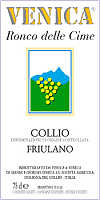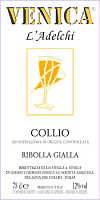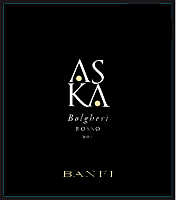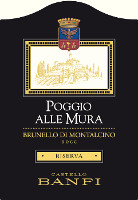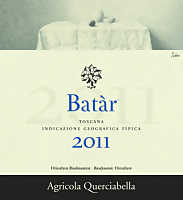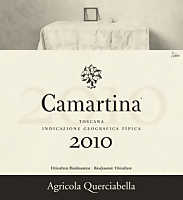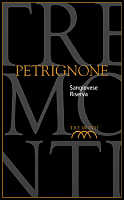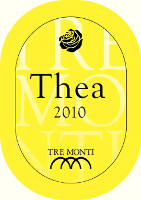|
There have been a times during which wine quality was frequently measured by
the use of barrique and the roundness perceived to the mouth. A period not so
distant in time, a little less than twenty years, in those times between the
relaunch of wine quality and the abuse of certain production techniques. Today
roundness is seen as a quality typical of those times, an unmistakable sign of
standardization that, at those times, represented both the norm and a wished
sensorial characteristic. This standardization, today openly denied and
rejected, was also associated to the use of two varieties in particular:
Chardonnay for white wines, Merlot for reds. These two varieties, associated to
the use of barrique, have been, undoubtedly, the main protagonists of the so
called round wines, and their use became pretty “normal” also in wines
produced with local grapes.
Roundness, of course, is not Chardonnay, Merlot and barrique only. It is, first
of all, a very important sensorial stimulus, indispensable - just like the
other ones - to the determination of wine balance. Just like every other
sensorial element participating to the definition of balance, roundness is not
a negative factor - as it is frequently considered today - nor a positive
quality. The intensity of its perception determines its agreeability, or better
to say, it becomes appropriate in a wine in function of the intensity of the
other gustatory elements. On this regard, it must be said both deficiency and
excess - a principle true for every other gustatory element - contribute to the
lack of balance. Moreover, it should be noticed, from a gustatory point of view,
balance, as well as persistence, is an important factor for the determination
of wine quality.
What is roundness in a wine? The first consideration to make it is a tactile
stimulus and not a gustative one. The perception of roundness can be simply
defined as the round sensation which can be found in mouth during
tasting. A sensation, like to say, viscous and thick, capable of giving wine a
less fluid character while giving a certain “volume”. Once roundness in a
wine was also called fattiness, a definition now almost disappeared from
the vocabulary of taster. In particular, a wine was defined “fat” when during
tasting was clearly perceived the presence of glycerol, one of the substances
responsible of roundness. For the sake of clearness, these “round” sensations
can be easily altered during production by adding specific substances, of them,
the most famous one certainly is gum arabic, a food additive also known as
E414 in Europe.
It should be said gum arabic is used in wine production as a stabilizing
substance, however it is undeniable its use contributes to increase roundness
of wine. In particular, gum arabic is used at the moment of bottling in order
to prevent possible faults in limpidity and in color of red and white wines.
Moreover, it is used for preventing the formation and the sedimentation of
tartrate. Despite its stabilizing properties, today gum arabic is widely used
in wine making and - it should be said - its presence in wine is not
perceptible during tasting. This means that, in the mouth, a wine to which was
added gum arabic will be perceived round and smooth just like a wine having its
own roundness qualities. Because of the use made of this substance, sometimes
also in excessive and unjustifiable quantity, it is legitimate to think about
its main usage as a “sensorial modifier” instead of a stabilizer.
|
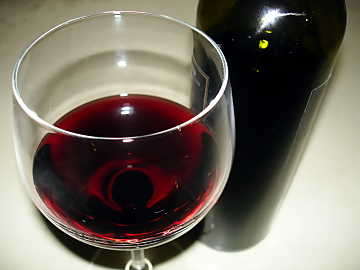 | |
| Large glass and mature wine: the
right condition to appreciate roundness in red wines | |
|
Roundness is the result of many factors, substances and elements developing
during wine production and aging. To them, like already said, are added all the
other substances used in some phases of production as well as the corrections
done in substances considered to be found in excessive quantity. Roundness is a
tactile sensation and it is essentially caused by the interaction of some
substances found in wine with tactile receptors of the oral cavity. In the
mouth, the sensation of roundness is clearly perceived to the center of tongue,
to the inner side of cheeks and to the palate. Also gums participate, although
marginally, to the perception of tactile sensations, however it must be noticed
they are mainly sensitive to the effects of astringency.
Apart from the substances added during production, among the elements making
roundness of a wine are included sugar, alcohol, polyols and, in particular,
glycerol. This latter substance is usually produced during alcoholic
fermentation - in a variable quantity from 2 to 11 grams per liter - and it is
one of the most important byproducts of this phase. From an organoleptic point
of view, glycerol does not have any aromatic property and it has a basically
sweet taste. Because of its viscous and thick nature, glycerol has the property
of increasing the sensation of roundness in a wine, while increasing the
structure and the perception of volume in the mouth. Sugar and ethyl alcohol,
the former having and evident sweet taste, the latter with a basically sweet
taste, contribute to sensation of roundness and smoothness of a wine.
The quantity of glycerol produced during fermentation depends on the specific
quality of the grapes, the quantity of sugar in the must and yeast. For this
reason there are grapes who can naturally make rounder wines than
others, an example is given by the famous Chardonnay and Merlot grapes. These
two varieties, despite they proved to have indisputable wine making qualities,
in particular in specific areas, they are frequently used to make certain
angular wines to taste rounder. The use of these grapes in fact
increases the sensation of roundness also in those wines produced with grapes
having a basically acidic and astringent character, therefore contributing to
wine balance. The use of these grapes is pretty common - and not only for their
contribution to roundness - and they are today found in a very high number of
wines. For this reason, today these varieties are considered the main
responsible of wine standardization and, associated to the use - or abuse - of
barrique, they determined the so called international taste.
The sensation of roundness is generally associated to sweet taste, a
characteristic which can be cause of confusion during the tasting of a wine. A
mistake commonly made by beginner tasters is to consider sweet a wine having an
evident roundness. Indeed, a round wine can also be absolutely dry, although it
should be noticed most of the substances determining this stimulus have a
basically sweet taste. Basically sweet does not mean sweet, or at least, this
stimulus is not clearly and evidently perceived as in the case, for example, of
sucrose, the common table sugar. A good example is given by certain wines made
from Gewürztraminer grape that, in most of the cases, are characterized by an
evident roundness although having an absolutely dry taste.
The perception of roundness is not associated to the substances making it only,
but also to the specific evolution state and the aging of wine. Intensity and
nature of roundness in a wine is also determined by the many processes of
evolution, capable of affecting the chemical characteristics of certain
elements as well as their molecular structure. Also some wine making techniques
and, in particular, the use of specific containers, can affect the development
of roundness, even substantially. A common case is the fermentation and aging
of wine in cask or barrique. The substances passed from wood to wine, as well
as the role played by oxygen during aging, can in fact contribute to roundness
and smoothness of a wine.
A young wine is characterized by a lower roundness, a quality accentuating
with time because of the phenomena happening during aging. On this regard, it
is certainly worth mentioning the so called malolactic fermentation,
better defined as malolactic conversion as during this process there is
no fermentation activity. During malolactic conversion, lactic bacteria convert
malic acid - typical in young wines - into lactic acid that, as opposed to the
other one, has a less aggressive character and it is rounder. The sensorial
result is to give wine a more accentuated roundness. The increasing of
roundness takes place also during aging in wood and, in particular, as a
consequence of the slow and minimal oxidation caused by the air entering the
cask through wood pores.
Moreover, time contributes to smooth the aggressive and astringent character of
polyphenolic substances, by favoring the polymerization of tannins and,
therefore, the aggregation of molecules which then becomes bigger. This
gives wine a rounder character while accentuating the sensation of roundness as
a result of a lower astringency. Like already said, alcohol contributes to the
definition of roundness. With a basically sweet taste - a quality which can be
clearly perceived at the end of the burning effect on the mucosa - alcohol
produces a tactile stimulus of roundness. For this reason, wines with a high
quantity of alcohol produce in the mouth a pretty round sensation, sometimes
excessive as to make the wine taste flat and with no lively quality.
From a gustatory point of view, round substances are opposed to the
hard ones in order to determine the right balance. The concept of
balance is defined according to the specific style of wine and its peculiar
characteristics. In red wines, for example, the model of balance must also
consider the presence of polyphenols. These elements, responsible of the
sensation of astringency, with a pretty harsh character, are considered to be
in a specific category and which however are balanced by round substances. The
sensation of roundness, which should not be confused with sweetness, plays and
effective role in balancing the sensation of astringency, also by giving the
wine a certain elegance and finesse. It is a matter of taste, of course, as for
some the evident acidic taste or the astringent character of wines is a
pleasing quality.
An excess of roundness makes a wine flat, with no character or vivacity,
becoming cloying in the worst cases. The modern preference of taste would seem
to not favor wines with an evident round character, both because they are
usually associated to the so called international taste and
because of the modern preference for those wines in which acidity is quite
evident. The concept of roundness also depends on the specific type of wine
and, in particular, the grapes with which it is produced. There are in fact
grapes which lose most of their personality and character in case roundness is
dominant, such as Pinot Noir, Nebbiolo, Riesling and Sauvignon Blanc. In mass
consumption, roundness is however appealing to many and may help
commercialization of wines. This characteristic is well known to certain
producers who, in this sense, sacrifices the real character of a wine with the
goal of meeting specific marketing demands and the taste of certain consumers.
|


